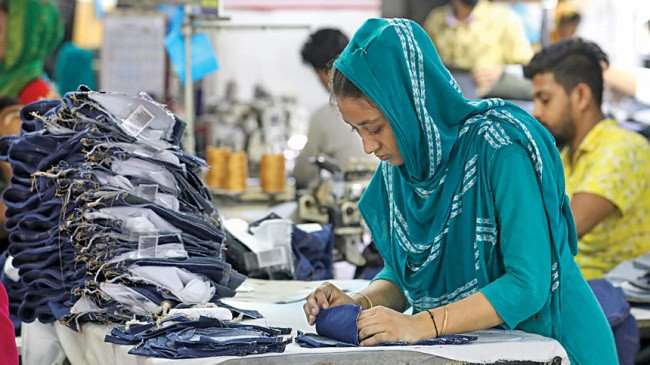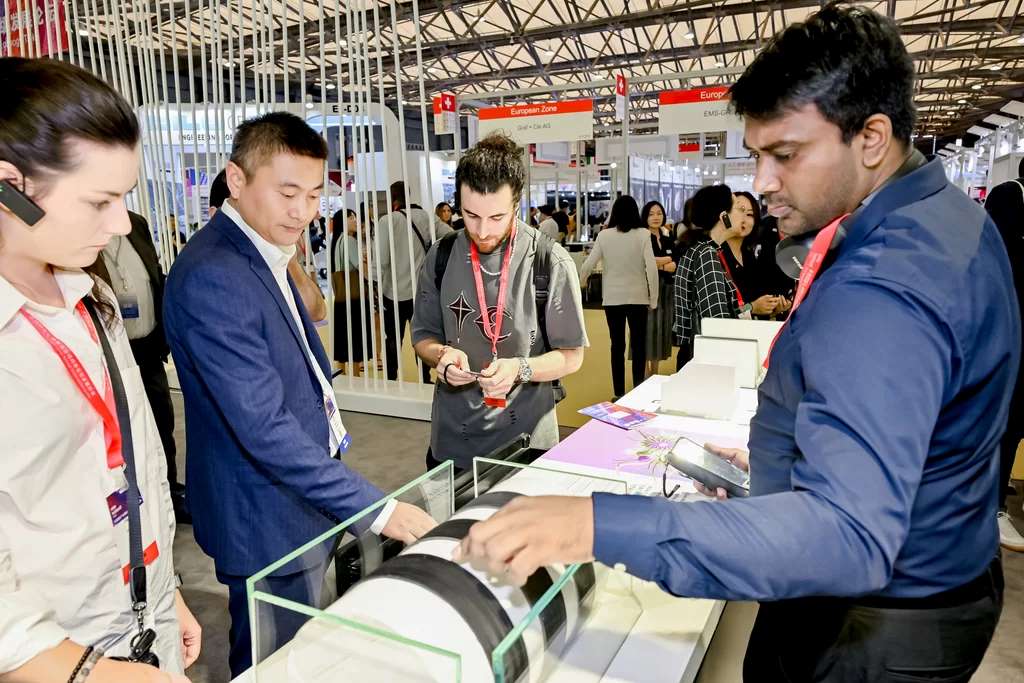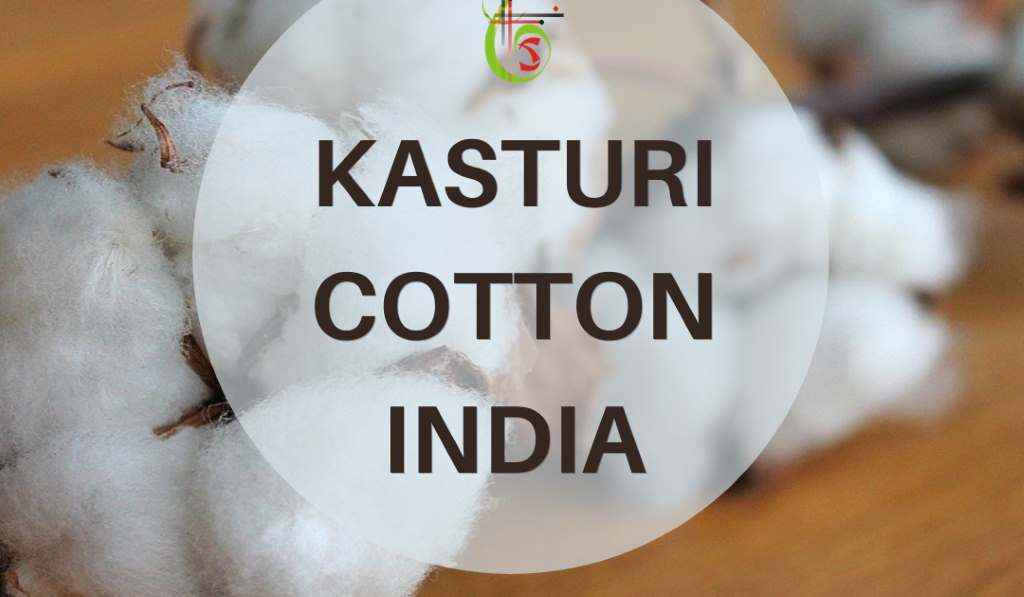FW
Leading Indian and overseas companies will converge at the IKF Complex in Tirupur from September 9 to 11, 2014 to showcase the latest in natural fibres like cotton, wool, silk & flax/ramie; man-made like regenerated & synthetic fibres; specialty fibres and well as natural, man-made, blended and elastic, fancy as well as specialty yarns at the 6th edition of Yarnex - India International yarn exhibition.
With each edition, Yarnex has grown into one of the most important trade shows for fibres and yarns in the country. This is where the textile value chain congregates to catch-up with the latest developments and indulges in business networking. The 2013 edition of Yarnex had over 3,000 high value customers from India and overseas visiting the show. The products showcased were from across the fibre groups, including specialized and high performance varieties that were new to this region.
Trade visitors will have access to high quality suppliers from India and overseas, including the leaders in this segment. With technical assistance ready at hand, knitters and weavers can discuss product development and commercial aspects which helps the decision-making process. Yarnex is organized by S S Textile Media, an organization that has been successfully conducting the F&A Show in Bangalore for 11 years and has added Homtex - the India International Home Textile Exhibition in 2012 to its portfolio.
Bangladesh will overhaul state-owned jute mills. They will be equipped with modern equipment and made operationally vibrant and commercially viable. There are 26 such mills in the country and Bangladesh will take the help of China for upgrading the mills. The Chinese government will provide a loan for the project at 1.5 per cent interest rate that will be payable within 20 years.
The hope is that these jute mills will be able to produce different types of high value jute textile products that have a wide range of demand in the local and international markets. These comprise products such as housing textiles, medical textiles, kitchen textiles and readymade garment textiles.
The project is expected to help integrate jute traders and jute growers under one umbrella through the contract farming system that will create a win-win situation for both sides in terms of financial benefit. Jute is considered the golden fiber of Bangladesh. And China has a big demand for jute goods, especially hessian cloth. Hessian cloth is an environment friendly product and is used for preserving tobacco leaf. China has stopped production of hessian cloth because of the high labor cost. So Bangladesh sees a big opportunity for exporting hessian to China. This will help reduce Bangladesh’s massive trade deficit with China.
The autumn edition of Interstoff Asia Essential will be held September 25 to 27, 2014, Hong Kong. This is a sourcing platform for fashionable, functional and eco fabrics and garment accessories in the region organized by Messe Frankfurt. It features exhibitors from leading fashion hubs in Asia, such as Hong Kong, Japan and Korea, and reveals the ensuing season’s trends.
The fair is also well-known for promoting the most advanced technologies. The research and education zone will have a strong focus on eco-friendly dyeing processes. A new partner in this area, the Korea High Tech Textile Research Institute, will demonstrate the world’s first ever liquid ammonia processing technology for knitted fabrics as well as its energy-efficient CPB dyeing system.
A dedicated area will display garment accessories. Products featured in this special zone are woven labels, embroidery webbings and various zippers and buttons. Environment friendly products will also be a feature at the show. New botanical-dyed mélange yarns will be displayed in 16 different colors. Among them, nine are using dyestuffs extracted from flowers while the other seven are from fruits.
Functional fabrics will feature nano porous waterproof fabrics, which are light, soft and excel in keeping users warm in extremely cold environments, as well as micro-pore dry membrane that offers excellent high-pressure water resistance. Fashion products include denim fabrics featuring jacquard and flocked and
interstoff-asia-spring.hk.messefrankfurt.com/
The International Textile Fair will be held from November 3 and 4, 2014, Dubai. The show will bring together textile manufacturers and designers from across the world. Companies from Italy, France, Spain, India, Pakistan, Mongolia, Taiwan and Hong Kong will be participating. The Middle East’s textile industry is estimated at $56 billion.
The fair will help participants find new customers in Dubai and across the region. This is the first international textile fair in Dubai. It has generated interest among Dubai's textile traders and the event is supported by the Textile Merchants Group, which represents 800 wholesale textile traders of Dubai. Traditionally, Dubai has been a strategic hub for the region’s textile trade. The fair is expected to give a global exposure to the region’s potential and give it a boost.
The UAE is the largest consumer of textiles in the Middle East. In 2011, the total import value of textile products was $13 billion. Revenues from UAE’s textile industry reached $13.2 billion in 2011 and recorded an annual cumulative growth of 9.9 per cent between 2006 and 2011. Textile production in Dubai notched an annual cumulative growth rate of 4 per cent between 2007 and 2011.
Sri Lanka's trade deficit narrowed substantially this year mainly due to increased clothing exports to the United States and Europe. Exports jumped 16.8 per cent in the first six months of 2014 compared to the same period last year. Imports declined 1.2 per cent compared to the same period last year.
Sri Lanka’s exports of garments to the EU jumped 34.6 per cent while those to the US increased 12.1 per cent. Retailers are increasingly turning to Sri Lanka, instead of traditional garment hubs such as Bangladesh, which is under international pressure over safety standards and conditions following a string of accidents. Sri Lanka’s economy recorded a growth of over eight per cent in the first two years since 2009 but since then growth has slowed down. Sri Lanka is one of the fastest growing economies in South Asia but the island is also vulnerable to sudden external shocks because of high levels of foreign commercial borrowings.
The country’s clothing sector is worth $4.5 billion. The aim is to reach an export target of $5 billion by 2016. Sri Lanka’s apparel export industry is almost entirely privately owned. It has grown over the last three decades and has become the number one foreign exchange earner and the largest single employer in the manufacturing industry.
A Dutch company, Feyecon, has developed a process to strip colors from dyed polyester textiles using super-critical CO2. This has the potential to accelerate closed-loop textile recycling by greatly improving the quality of recycled raw material inputs. Research is underway to see if this technique can be used to remove textile finishes and other auxiliary chemicals from fabrics.
Feyecon, a partner in joint venture company DyeCoo, which produces CO2 textile dyeing machines, says it’s the only company to consider dye removal from polyester textile waste using its own pressurised fluid technology. Given the early commercial success of DyeCoo technology, which is currently being used to dye textiles without the use of water for brands such as Nike and Adidas, Fayecon decided to experiment with reversing this technique to bleach dyed polyester textiles.
The removed dyes are then dissolved in the CO2, thus avoiding the use of organic solvents or other caustic chemicals to decolorise fabrics. The decolorisation step will also dry the synthetic textile fiber polymer, which will help to limit degradation during recycling. The company is also investigating whether this technology can be applied to remove finishing chemicals and auxiliaries from fabrics. Feyecon claims the dye can be recycled.
www.feyecon.com/
Global production of digitally printed textiles is growing at an annual rate of 25 per cent and at present, digitally printed textiles account for just 2 per cent of total printed textile production worldwide. It is expected to account for 5 per cent share by 2017. According to a report by Textile Intelligence, digital textile printing offers greater freedom of creativity and flexibility in design and is more cost efficient for short print runs, providing scope of expansion for the digital textile-printing industry.
While the production of digitally printed textiles is currently weighted heavily towards developing countries, however, there is likely to be an increase in production in Europe in the future. The increase in production in European countries will be driven by the fact that some European textile companies are planning to shift digital printing to Europe to satisfy local tastes, facilitate quick response manufacturing, release a greater number of collections each year and serve the fast fashion market better.
There are opportunities for expansion in the luxury apparel segment as digital textile printing enables retailers of luxury apparel to produce small quantities of high quality, limited edition pieces cost efficiently. Further scope for expansion lies in the area of mass customisation, whereby a consumer is able to personalise a product by choosing a design on a dedicated web page in a retailer's online store for subsequent production by a digital textile printer.
The Textile Institute World Conference, TIWC 2014, will take place from November 2 to 6, China. TIWC 2014 is a platform that gathers researchers, academics and the industries related to the areas of textiles, clothing and footwear. The conference is organised every one and a half years by the Textile Institute in various locations around the world such as Sri Lanka, Hong Kong, England and Malaysia.
The conference aims to provide a significant platform for industry and researchers around the world to meet, discuss, share and disseminate findings for future collaborations. It will specifically focus on textile innovation from fiber to fashion in both research and industrial applications.
The Textile Institute is the only international organisation for textiles, clothing and footwear industries. It was founded in 1910. Members consist of individuals and corporate members in up to 80 countries. Membership covers all sectors and all disciplines in textiles, clothing and footwear.
Developments in textile materials, equipment and processes have extensively impacted the textile industry worldwide. Innovations from fiber to fashion in textiles not only provide opportunities for development of traditional textiles but also expand the industry into non-conventional markets such as technical textiles and composites with value-added elements.
www.tiworldconference.org/info/1015/1003.htm
A two-day exhibition of Indian textiles was held in Ethiopia last week (August 13 and 14). It was organized by the Ethiopian Chamber of Commerce and Sectorial Association along with the Indian embassy and the Synthetic and Rayon Textiles Promotion Council. About 20 Indian textile companies took part and exhibited a wide range of products including shirts, suits, fabrics, yarns and embroidery products.
The aim was to strengthen bilateral trade, particularly in man-made textiles. India’s synthetic and rayon textiles industry is currently worth $600 million and exports to more than 140 countries. India's total synthetic and rayon output is around 21 million sq. mt.
India is investing billions of dollars in Ethiopia. Trade and investment relationship between the two countries has shown significant progress. From 1992 to 2012, a total of 365 Indian firms took investment licenses for different projects in Ethiopia. The total trade turnover was $1.3 billion between the two countries in 2013. There are 140 textile factories in Ethiopia, seven of these are Indian companies. India’s 2013 export of textile and clothing products was $40 billion, which the country plans to double to $80 billion by 2020.
India may replace China as the world's largest cotton producer in the next marketing year. The country is expected to produce 39.62 million bales in 2014-15 compared with 40.05 million bales in the current year. In contrast the Chinese crop would be lower in 2014-15 as it has started focusing more on food crops while crop coverage in India could hit a record if the weather remains favorable.
A bumper harvest in India for a second straight year will further pressure global cotton futures, which have already dropped 24 per cent so far this year, as global year-ending stocks are estimated to rise for a fifth straight season. However, Indian cotton exports could drop in 2014-15 as its biggest buyer China is offloading its own inventory and cutting down on purchases from overseas.
Global trade could decline 12 per cent in 2014-15, as Chinese imports could come down by 26 per cent. India is the second largest producer of cotton in the world after China accounting for about 18 per cent of world cotton production. It has the largest area under cotton cultivation in the world ranging between 12.2 million hectares and constituting about 25 per cent of the world area under cotton cultivation. The yield per hectare is, however, the lowest against the world average. Over the last two years it has shown potential to reach world average levels in the near future.












